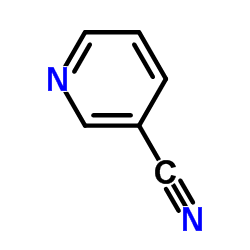3-Cyanopyridine

3-Cyanopyridine structure
|
Common Name | 3-Cyanopyridine | ||
|---|---|---|---|---|
| CAS Number | 100-54-9 | Molecular Weight | 104.109 | |
| Density | 1.1±0.1 g/cm3 | Boiling Point | 203.0±13.0 °C at 760 mmHg | |
| Molecular Formula | C6H4N2 | Melting Point | 48-52 °C(lit.) | |
| MSDS | Chinese USA | Flash Point | 84.4±0.0 °C | |
| Symbol |

GHS07 |
Signal Word | Warning | |
|
Akt-mediated regulation of antidepressant-sensitive serotonin transporter function, cell-surface expression and phosphorylation.
Biochem. J. 468 , 177-90, (2015) The serotonin [5-HT (5-hydroxytryptamine)] transporter (SERT) controls serotonergic neurotransmission in the brain by rapid clearance of 5-HT from the synaptic cleft into presynaptic neurons. SERTs are primary targets for antidepressants for therapeutic inter... |
|
|
Self-assembled hybrid metal oxide base catalysts prepared by simply mixing with organic modifiers.
Nat. Commun. 6 , 8580, (2015) Multidentate materials formed by simply mixing heterogeneous and homogeneous components are promising for construction of versatile active sites on the surface of heterogeneous compounds, however, to the best of our knowledge, there are no reports on such mat... |
|
|
The WNT/β-Catenin Pathway Is a Transcriptional Regulator of CYP2E1, CYP1A2, and Aryl Hydrocarbon Receptor Gene Expression in Primary Human Hepatocytes.
Mol. Pharmacol. 86(6) , 624-34, (2014) The wingless-type MMTV integration site family (WNT)/β-catenin/adenomatous polyposis coli (CTNNB1/APC) pathway has been identified as a regulator of drug-metabolizing enzymes in the rodent liver. Conversely, little is known about the role of this pathway in d... |
|
|
Analysis of Glycogen Synthase Kinase Inhibitors That Regulate Cytochrome P450 Expression in Primary Human Hepatocytes by Activation of β-Catenin, Aryl Hydrocarbon Receptor and Pregnane X Receptor Signaling.
Toxicol. Sci. 148 , 261-75, (2015) Cytochrome P450 (CYP) expression and activity are not homogeneous in the liver lobules. Indeed, CYPs are mainly expressed and induced in centrilobular hepatocytes. The wingless-type MMTV integration site family (WNT)/β-catenin pathway was identified as a majo... |
|
|
Improving the catalytic potential and substrate tolerance of Gibberella intermedia nitrilase by whole-cell immobilization.
Bioprocess Biosyst. Eng. 38(1) , 189-97, (2015) Comparative studies of immobilized and free cells of Gibberella intermedia CA3-1 in bioconversion of 3-cyanopyridine to nicotinic acid were performed. Entrapping method was chosen based on the advantages in enzymatic activity recovery, mechanical strength and... |
|
|
Fungal His-tagged nitrilase from Gibberella intermedia: gene cloning, heterologous expression and biochemical properties.
PLoS ONE 7(11) , e50622, (2012) Nitrilase is an important member of the nitrilase superfamiliy. It has attracted substantial interest from academia and industry for its function of converting nitriles directly into the corresponding carboxylic acids in recent years. Thus nitrilase has playe... |
|
|
An improved nitrilase-mediated bioprocess for synthesis of nicotinic acid from 3-cyanopyridine with hyperinduced Nocardia globerula NHB-2.
J. Ind. Microbiol. Biotechnol. 38(9) , 1235-43, (2011) Nitrilase of Nocardia globerula NHB-2 was induced by short-chain aliphatic nitriles (valeronitrile > isobutyronitrile > butyronitrile > propionitrile) and exhibited activity towards aromatic nitriles (benzonitrile > 3-cyanopyridine > 4-cyanopyridine > m-tolun... |
|
|
Biosynthesis of nicotinic acid from 3-cyanopyridine by a newly isolated Fusarium proliferatum ZJB-09150.
World J. Microbiol. Biotechnol. 29(3) , 431-40, (2013) In this study, nitriles were used as sole sources of nitrogen in the enrichments to isolate nitrile-converting microorganisms. A novel fungus named ZJB-09150 possessing nitrile-converting enzymes was obtained with 3-cyanopyridine as sole source of nitrogen, w... |
|
|
Characterization of a newly isolated strain Rhodococcus erythropolis ZJB-09149 transforming 2-chloro-3-cyanopyridine to 2-chloronicotinic acid.
New Biotechnology 28(6) , 610-5, (2011) 2-Chloronicotinic acid is receiving much attention for its effective applications as a key precursor in the synthesis of pesticides and medicines. In this study, a strain ZJB-09149 converting 2-chloro-3-cyanopyridine to 2-chloronicotinic acid was newly isolat... |
|
|
Cloning, expression and functional analysis of nicotinate dehydrogenase gene cluster from Comamonas testosteroni JA1 that can hydroxylate 3-cyanopyridine.
Biodegradation 21(4) , 593-602, (2010) A nicotinate dehydrogenase (NaDH) gene cluster was cloned from Comamonas testosteroni JA1. The enzyme, termed NaDH(JA1), is composed of 21, 82, and 46 kDa subunits, respectivley containing [2Fe2S], Mo(V) and cytochrome c domains. The recombinant NaDH(JA1) can... |